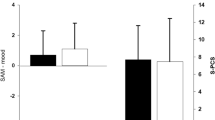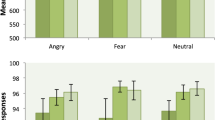Abstract
Rationale
Serotonergic processes have been implicated in the modulation of fear conditioning in humans, postulated to occur at the level of the amygdala. The processing of other fear-relevant cues, such as facial expressions, has also been associated with amygdala function, but an effect of serotonin depletion on these processes has not been assessed.
Objective
The present study investigated the effects of reducing serotonin function, using acute tryptophan depletion, on the recognition of basic facial expressions of emotions in healthy male and female volunteers.
Methods
A double-blind between-groups design was used, with volunteers being randomly allocated to receive an amino acid drink specifically lacking tryptophan or a control mixture containing a balanced mixture of these amino acids. Participants were given a facial expression recognition task 5 h after drink administration. This task featured examples of six basic emotions (fear, anger, disgust, surprise, sadness and happiness) that had been morphed between each full emotion and neutral in 10% steps. As a control, volunteers were given a famous face classification task matched in terms of response selection and difficulty level.
Results
Tryptophan depletion significantly impaired the recognition of fearful facial expressions in female, but not male, volunteers. This was specific since recognition of other basic emotions was comparable in the two groups. There was also no effect of tryptophan depletion on the classification of famous faces or on subjective state ratings of mood or anxiety.
Conclusions
These results confirm a role for serotonin in the processing of fear related cues, and in line with previous findings also suggest greater effects of tryptophan depletion in female volunteers. Although acute tryptophan depletion does not typically affect mood in healthy subjects, the present results suggest that subtle changes in the processing of emotional material may occur with this manipulation of serotonin function.




Similar content being viewed by others
References
Adolphs R, Tranel D, Damasio H, Damasio A (1994) Impaired recognition of emotion in facial expressions following bilateral damage to the human amygdala . Nature 372:669–672
Adolphs R, Tranel D, Hamann S, Young AW, Calder AJ, Phelps EA, Anderson A, Lee GP, Damasio AR (1999) Recognition of facial emotion in nine individuals with bilateral amygdala damage. Neuropsychologia 37:1111–1117
Amat J, Matus-Amat P, Watkins LR, Maier SF (1998) Escapable and inescapable stress differentially alter extracellular levels of 5-HT in the basolateral amygdala of the rat. Brain Res 812:113–120
Bagdy G, Graf M, Anheuer ZE, Modos EA, Kantor S (2001) Anxiety-like effects induced by acute fluoxetine, sertraline or m-CPP treatment are reversed by pretreatment with the 5-HT2C receptor antagonist SB-242084 but not the 5-HT1A receptor antagonist WAY-100635. Int J Neuropsychopharmacol 4:399–408
Borsini F, Podhorna J, Marazziti D (2002) Do animal models of anxiety predict anxiolytic-like effects of antidepressants? Psychopharmacology 163:121–141
Davis M, Whalen PJ (2001) The amygdala: vigilance and emotion. Mol Psychiatry 6:13–34
Deakin JF (1991) Depression and 5HT. Int Clin Psychopharmacol 6:23–28
Ekman P, Friesen WV (1976) Pictures of facial affect. Palo Alto, Calif.
Ellenbogen MA, Young SN, Dean P, Palmour RM, Benkelfat C (1996) Mood response to acute tryptophan depletion in healthy volunteers: sex differences and temporal stability. Neuropsychopharmacology 15:465–474
Goodwin GM, Fairburn CG, Cowen PJ (1987) Dieting changes serotonergic function in women, not men: implications for the aetiology of anorexia nervosa? Psychol Med 17:839–842
Goodwin GM, Cowen PJ, Fairburn CG, Parry-Billings M, Calder PC, Newsholme EA (1990) Plasma concentrations of tryptophan and dieting. BMJ 300:1499–1500
Graeff FG, Viana MB, Mora PO (1997) Dual role of 5-HT in defense and anxiety. Neurosci Biobehav Rev 21:791–799
Harmer CJ, Bhagwagar Z, Perrett DI, Völlm BA, Cowen PJ, Goodwin GM (2003) Acute SSRI administration affects the processing of social cues in healthy volunteers. Neuropsychopharmacology 28:148–152
Harmer CJ, Shelley NC, McTavish SFB, Cowen PJ, Goodwin GM (2002) Repeated administration of citalopram or reboxetine reduces the perception of negative emotions from facial expression. J Psychopharmacol S16, A70
Hashimoto S, Inoue T, Koyama T (1999) Effects of conditioned fear stress on serotonin neurotransmission and freezing behavior in rats. Eur J Pharmacol 378:23–30
Hellewell JS, Guimaraes FS, Wang M, Deakin JF (1999) Comparison of buspirone with diazepam and fluvoxamine on aversive classical conditioning in humans. J Psychopharmacol 13:122–127
Hensman R, Guimaraes FS, Wang M, Deakin JF (1991) Effects of ritanserin on aversive classical conditioning in humans. Psychopharmacology 104:220–224
Kent JM, Coplan JD, Gorman JM (1998) Clinical utility of the selective serotonin reuptake inhibitors in the spectrum of anxiety. Biol Psychiatry 44:812–824
Manji HK, Drevets WC, Charney DS (2001) The cellular neurobiology of depression. Nat Med 7:541–547
Maren S (2001) Neurobiology of Pavlovian fear conditioning. Annu Rev Neurosci 24:897–931
Martin JR, Ballard TM, Higgins GA (2002) Influence of the 5-HT2C receptor antagonist, SB-242084, in tests of anxiety. Pharmacol Biochem Behav 71:615–625
Morris JS, Frith CD, Perrett DI, Rowland D, Young AW, Calder AJ, Dolan RJ (1996) A differential neural response in the human amygdala to fearful and happy facial expressions. Nature 383:812–815
Nelson HE, O'Connell A (1978) Dementia: the estimation of premorbid intelligence levels using the New Adult Reading Test. Cortex 14:234–244
Nishizawa S, Benkelfat C, Young SN, Leyton M, Mzengeza S, de Montigny C, Blier P, Diksic M (1997) Differences between males and females in rates of serotonin synthesis in human brain. Proc Natl Acad Sci USA 94:5308–5313
Reilly JG, McTavish SF, Young AH (1997) Rapid depletion of plasma tryptophan: a review of studies and experimental methodology. J Psychopharmacol 11:381–392
Salomon RM, Miller HL, Krystal JH, Heninger GR, Charney DS (1997) Lack of behavioral effects of monoamine depletion in healthy subjects. Biol Psychiatry 41:58–64
Silva M, Hetem LA, Guimaraes FS, Graeff FG (2001) Opposite effects of nefazodone in two human models of anxiety. Psychopharmacology 156:454–460
Smith KA, Fairburn CG, Cowen PJ (1997) Relapse of depression after rapid depletion of tryptophan. Lancet 349:915–919
Van der Does AJ (2001) The effects of tryptophan depletion on mood and psychiatric symptoms. J Affect Disord 64:107–119
Watson D, Clark LA, Tellegen A (1988) Development and validation of brief measures of positive and negative affect: the PANAS scales. J Person Soc Psychol 54:1063–1070
Young AW, Rowland D, Calder AJ, Etcoff NL, Seth A, Perrett DI (1997) Facial expression megamix: tests of dimensional and category accounts of emotion recognition. Cognition 63:271–313
Zhang ZJ, Schmidt DE, de Paulis T, Trivedi BL, Onaivi ES, Ebert MH, Hewlett WA (2001) Anxiolytic-like effects of DAIZAC, a selective high-affinity 5-HT(3) receptor antagonist, in the mouse elevated plus-maze. Pharmacol Biochem Behav 69:571–578
Author information
Authors and Affiliations
Corresponding author
Rights and permissions
About this article
Cite this article
Harmer, C.J., Rogers, R.D., Tunbridge, E. et al. Tryptophan depletion decreases the recognition of fear in female volunteers. Psychopharmacology 167, 411–417 (2003). https://doi.org/10.1007/s00213-003-1401-6
Received:
Accepted:
Published:
Issue Date:
DOI: https://doi.org/10.1007/s00213-003-1401-6




